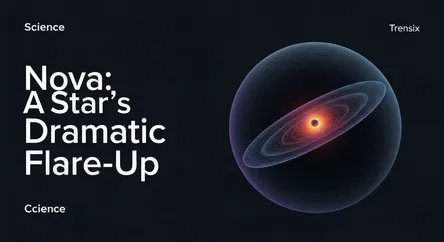Science
Nova: A Star's Dramatic Flare-Up

Discover the science behind a nova, a powerful stellar explosion from a white dwarf star. Learn why these cosmic events captivate astronomers.
What is it?
A nova is a powerful astronomical event causing the sudden, dramatic brightening of a star. It occurs in a binary star system where a dense white dwarf star siphons hydrogen gas from its larger companion. This material accumulates on the white dwarf's surface, eventually becoming so hot and dense that it ignites a runaway nuclear fusion reaction. This explosion blasts the accumulated material into space, creating a brilliant, but temporary, burst of light. Unlike a supernova, which destroys its parent star, a nova only expels the surface layer, leaving the white dwarf intact and able to repeat the process.
Why is it trending?
Novas often gain public attention when a particularly bright one occurs or is predicted to become visible. A prime example is the recurring nova T Coronae Borealis, which is anticipated to erupt sometime in 2024. This upcoming event has generated significant buzz because it will be bright enough to be seen with the naked eye, offering a rare and exciting celestial spectacle for stargazers worldwide. Such predictable events allow both professional and amateur astronomers to prepare for observation, fueling widespread interest.
How does it affect people?
While novas occur too far away to pose any direct threat to Earth, they have a significant impact on our understanding of the cosmos. Studying these explosions helps scientists refine theories of stellar evolution and nuclear physics. They also serve as cosmic distance markers, helping astronomers map the universe. For the public, a visible nova is an awe-inspiring event that fosters a connection to the vastness of space. It's a powerful educational moment, inspiring curiosity about astronomy and our place in the universe, turning many eyes towards the night sky.